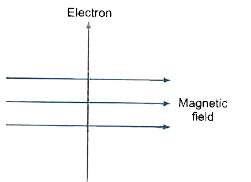The net charge in a current-carrying conductor is zero, even then it experiences a force in a magnetic field. Why?
To understand why a current-carrying conductor experiences a force in a magnetic field despite having a net charge of zero, we can break down the explanation into several steps:
1. Understanding Current and Charge:
- A current-carrying conductor consists of charged particles, primarily electrons. In a neutral conductor, the number of positive charges (like protons) equals the number of negative charges (electrons), leading to a net charge of zero.
2. Movement of Charges:
- When a potential difference is applied across the conductor, electrons gain energy and start moving. This movement of electrons constitutes an electric current. The drift velocity of these electrons is what creates the current flow.
3. Magnetic Field Interaction:
- When this current-carrying conductor is placed in a magnetic field, the moving charges (electrons) interact with the magnetic field. According to the Lorentz force law, a charge moving in a magnetic field experiences a force given by the equation:
F=q(v×B)
- Here, q is the charge, v is the velocity of the charge, and B is the magnetic field.
4. Force on the Conductor:
- Even though the net charge in the conductor is zero, the individual moving charges (electrons) experience a force due to their motion in the magnetic field. This force acts on all the moving charges in the conductor, resulting in a net force on the entire conductor.
5. Summation of Forces:
- The total force on the conductor can be calculated by considering small segments of the wire. Each segment has a small amount of charge that experiences a force due to the magnetic field. By integrating these forces over the entire length of the conductor, we can find the total force acting on it.
6. Conclusion:
- Therefore, the force experienced by the current-carrying conductor in a magnetic field arises from the motion of the individual charges (electrons) within it, even though the overall charge of the conductor remains neutral.
- A current-carrying conductor consists of charged particles, primarily electrons. In a neutral conductor, the number of positive charges (like protons) equals the number of negative charges (electrons), leading to a net charge of zero.
- When a potential difference is applied across the conductor, electrons gain energy and start moving. This movement of electrons constitutes an electric current. The drift velocity of these electrons is what creates the current flow.
- When this current-carrying conductor is placed in a magnetic field, the moving charges (electrons) interact with the magnetic field. According to the Lorentz force law, a charge moving in a magnetic field experiences a force given by the equation:
F=q(v×B)
- Here, q is the charge, v is the velocity of the charge, and B is the magnetic field.
- Even though the net charge in the conductor is zero, the individual moving charges (electrons) experience a force due to their motion in the magnetic field. This force acts on all the moving charges in the conductor, resulting in a net force on the entire conductor.
- The total force on the conductor can be calculated by considering small segments of the wire. Each segment has a small amount of charge that experiences a force due to the magnetic field. By integrating these forces over the entire length of the conductor, we can find the total force acting on it.
- Therefore, the force experienced by the current-carrying conductor in a magnetic field arises from the motion of the individual charges (electrons) within it, even though the overall charge of the conductor remains neutral.
Topper's Solved these Questions
- MAGNETIC EFFECT OF CURRENT AND MAGNETISMBOOK - PRADEEPCHAPTER - MAGNETIC EFFECT OF CURRENT AND MAGNETISMEXERCISE - Conceptual Problems (d)
2 Videos
- MAGNETIC EFFECT OF CURRENT AND MAGNETISMBOOK - PRADEEPCHAPTER - MAGNETIC EFFECT OF CURRENT AND MAGNETISMEXERCISE - Very Short Answer Questions (a)
2 Videos
- ELECTROSTATICSBOOK - PRADEEPCHAPTER - ELECTROSTATICSEXERCISE - ASSERTION-REASON TYPE QUESTIONS
2 Videos
- OPTICSBOOK - PRADEEPCHAPTER - OPTICSEXERCISE - Multiple choice questions
1 Videos
Similar Questions
Knowledge Check
The magnetic field near a current carrying conductor is given by
ACoulomb’s lawBLenz’ lawCBiot-savart’s lawDKirchoff’s lawThe net charge in a current carrying wire is zero. Them, why does a magnetic field exert a force on it?
AStationary chargeBMoving chargeCA positive charge onlyDA negative charge onlyWhen a current carrying conductor is placed in magnetic field, then:
AIt always experience a forceBIt may experience a forceCIt never experience a forceDNone of the above
Magnetic Force On A Current Carrying Conductor
View SolutionThe net charge in a current carrying wire is zero. Them, why does a magnetic field exert a force on it?
View SolutionThe magnetic field in a straight current carrying conductor wire is:
View Solution(a) Explain an activity to show that a current-carrying conductor experiences a force when placed in a magnetic field.
(b) State the rule which gives the direction of force acting on the conductor.
(c ) An electron moves perpendicular to a magnetic field as shown in the figure.
What would be the direction of force experienced on the electron?

View SolutionDescribe the experiment to explain that force acts on a current carrying conductor in presence of a magnetic field.
View Solution
